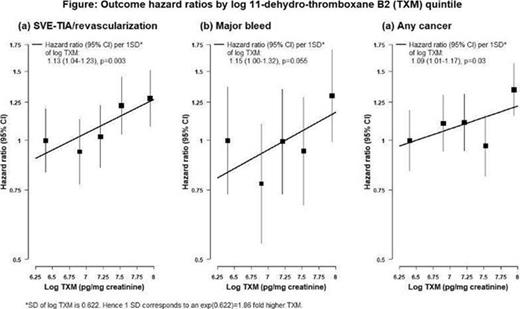-
PDF
- Split View
-
Views
-
Cite
Cite
B Rocca, G Buck, G Petrucci, S Parish, F Pagliaccia, C Baigent, M Mafham, L Bowman, J Armitage, C Patrono, The ASCEND Study Collaborative Group , Thromboxane metabolite excretion is associated with serious vascular events in diabetes mellitus: a sub-study of the ASCEND trial, European Heart Journal, Volume 41, Issue Supplement_2, November 2020, ehaa946.2926, https://doi.org/10.1093/ehjci/ehaa946.2926
Close - Share Icon Share
Abstract
Platelet activation plays a major role in the atherothrombotic complications of diabetes. Thromboxane (TX)A2 is a pro-thrombotic prostanoid, synthesized via cyclooxygenase-1 and released by activated platelets. The metabolism of TXA2 in vivo leads to a major stable end-product, 11-dehydro-TXB2 (TXM), measurable in urine and reflecting the whole-body rate of TXA2 biosynthesis. In two large trials of high-risk, aspirin-treated (mostly, without diabetes) patients, (CHARISMA and HOPE trials), the baseline rate of urinary TXM excretion was an independent predictor of future cardiovascular events.
The aim of the ASCEND (A Study of Cardiovascular Events in Diabetes) TXM sub-study was to investigate the association between baseline urinary TXM and future serious vascular events or revascularization (SVE-R), major bleeds and incident cancer independent of other risk factors and treatment, in people with diabetes and no manifest cardiovascular disease at trial entry.
Urinary TXM was measured by a previously GC/MS-validated, immunoassay in 6,487 participants with eligible baseline samples. Analyses excluded 539 participants using NSAIDs. TXM appeared log-normally distributed, so analyses were by quintiles and per SD (=0.622) of continuous loge TXM. The association of loge TXM with outcome was adjusted by basic factors (age, sex, sample volume and randomized treatment allocation) and by the predictors of log TXM (smoking, type 2 diabetes treated with insulin or oral hypoglycaemics, HDL cholesterol, body mass index, urinary albumin/creatinine ratio, eGFR). The association of log TXM with non-vascular, non-cancer MedDRA outcomes was investigated to determine whether TXM had a general effect on outcome. During a mean of 6.6 years follow-up there were 618 SVE-Rs, 206 bleeds and 700 cancers among these patients.
Log TXM correlated significantly with SVE-R, hazard ratio (HR) per 1 SD of log TXM: 1.13 (1.04–1.23), p=0.003 (Figure 1, panel a), non-significantly with major bleeds [HR 1.15 (1.00–1.32), p=0.055] (Figure 1, panel b), and marginally significantly with cancer [HR 1.09 (1.01–1.17), p=0.03] (Figure 1, panel c). There was no association of log TXM with non-vascular non-cancer MedDRA outcomes (HR per 1 SD, 0.99; 99% CI, 0.94–1.05).
The rate of urinary TXM excretion, a non-invasive biomarker of TXA2-mediated platelet activation in vivo, is log-linearly associated with serious vascular events independent of other risk factors in people with diabetes. Its potential association with cancer must be viewed as hypothesis-generating and needs confirmation.

Figure 1
Type of funding source: Public grant(s) – EU funding. Main funding source(s): IMI1: Surrogate markers for micro- and macro-vascular hard endpoints for innovative diabetes tools (SUMMIT).
- aspirin
- prostaglandins
- smoking
- high density lipoprotein cholesterol
- body mass index procedure
- cardiovascular diseases
- diabetes mellitus
- metabolism
- excretory function
- heart disease risk factors
- blood platelets
- albumins
- diabetes mellitus, type 2
- thromboxane
- cancer
- creatinine
- anti-inflammatory agents, non-steroidal
- biological markers
- follow-up
- immunoassay
- platelet activation
- thromboxane a2
- thromboxane b2
- urinary tract
- insulin
- microbiology procedures
- urine
- thrombus
- oral hypoglycemic agents
- cyclooxygenase-1
- revascularization
- surrogate markers
- cardiovascular event
- metabolites
- surrogate endpoints
- biosynthesis
- prevention
- ascend trial
- heart sound a2



